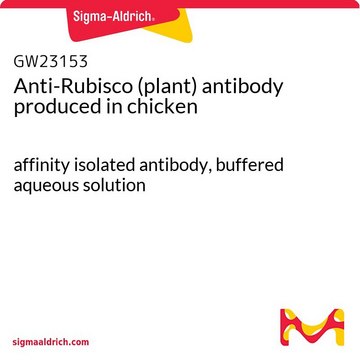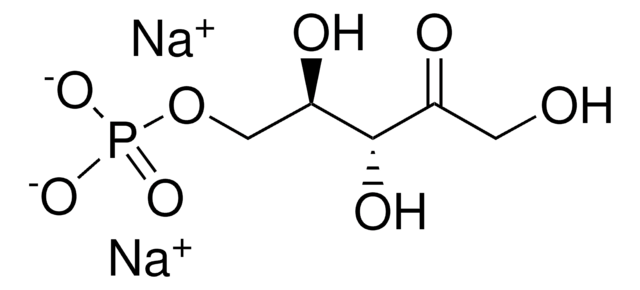R8000
D-Ribulose 1,5-Diphosphate Carboxylase from spinach
partially purified powder, 0.01-0.1 unit/mg solid
Sinónimos:
3-Phospho-D-glycerate carboxy-lyase(dimerizing), Rubisco
Iniciar sesiónpara Ver la Fijación de precios por contrato y de la organización
About This Item
Número de CAS:
Número MDL:
Código UNSPSC:
12352204
NACRES:
NA.54
Productos recomendados
origen biológico
spinach
Nivel de calidad
Formulario
partially purified powder
actividad específica
0.01-0.1 unit/mg solid
mol peso
557 kDa
temp. de almacenamiento
−20°C
Descripción general
D-Ribulose 1,5-Diphosphate Carboxylase (RUBISCO) amounts to 50% of the total spinach leaves associated soluble protein.
Exists as a 557 kDa hexadecamer composed of eight heavy chains each with a molecular weight of approximately 56 kDa and eight light chains of molecular weight 14 kDa. Each molecule contains one magnesium ion.
pH optimum: ~7.9.
KM for CO2: ~0.45 mM.
Ribulose diphosphate becomes inhibitory at concentrations exceeding 0.7 mM. Orthophosphate and ammonium sulfate are competitive inhibitors. 3-Phosphoglycerate is a noncompetitive inhibitor.
pH optimum: ~7.9.
KM for CO2: ~0.45 mM.
Ribulose diphosphate becomes inhibitory at concentrations exceeding 0.7 mM. Orthophosphate and ammonium sulfate are competitive inhibitors. 3-Phosphoglycerate is a noncompetitive inhibitor.
Aplicación
D-Ribulose 1,5-Diphosphate Carboxylase from spinach has been used:
- as a test protein in pepsin digestion studies
- as an innocuous or non-hazardous protein sample to test its effect on human intestinal epithelial cell lines
- in isothermal titration calorimetry (ITC), and radiolabeled binding assays with abscisic acid
Acciones bioquímicas o fisiológicas
D-Ribulose 1,5-Diphosphate Carboxylase (RUBISCO) depends on Rubisco activase and chaperones for activation. It participates in plant photorespiration events by catalyzing the carboxylation and oxygenation of ribulose-1,5-bisphosphate. Abscisic acid inhibits the carboxylation activity of Rubisco.
Definición de unidad
One unit will convert 1.0 μmole of D-RuDP and CO2 to 2.0 μmoles of D-3-phosphoglycerate per min at pH 7.8 at 25°C.
Palabra de señalización
Danger
Frases de peligro
Consejos de prudencia
Clasificaciones de peligro
Resp. Sens. 1
Código de clase de almacenamiento
11 - Combustible Solids
Clase de riesgo para el agua (WGK)
WGK 1
Punto de inflamabilidad (°F)
Not applicable
Punto de inflamabilidad (°C)
Not applicable
Equipo de protección personal
Eyeshields, Gloves, type N95 (US)
Elija entre una de las versiones más recientes:
Certificados de análisis (COA)
Lot/Batch Number
¿No ve la versión correcta?
Si necesita una versión concreta, puede buscar un certificado específico por el número de lote.
¿Ya tiene este producto?
Encuentre la documentación para los productos que ha comprado recientemente en la Biblioteca de documentos.
Yuji Suzuki et al.
Journal of experimental botany, 64(4), 1145-1152 (2013-01-26)
Rubisco gene expression was examined in detail in rice (Oryza sativa L.) leaves at different positions, i.e. expanding, mature, and senescent leaves. Rubisco small subunit (RBCS) synthesis and RBCS mRNA levels were maximal in expanding leaves and gradually became lower
Romain A Studer et al.
Proceedings of the National Academy of Sciences of the United States of America, 111(6), 2223-2228 (2014-01-29)
A well-known case of evolutionary adaptation is that of ribulose-1,5-bisphosphate carboxylase (RubisCO), the enzyme responsible for fixation of CO2 during photosynthesis. Although the majority of plants use the ancestral C3 photosynthetic pathway, many flowering plants have evolved a derived pathway
Libor Vítek et al.
Antioxidants (Basel, Switzerland), 11(11) (2022-11-12)
Oxidative stress and inflammation contribute significantly to atherogenesis. We and others have demonstrated that mildly elevated serum bilirubin levels protect against coronary and peripheral atherosclerosis, most likely due to the antioxidant and anti-inflammatory activities of bilirubin. The aim of the
Hiroyuki Ishida et al.
Biochimica et biophysica acta, 1837(4), 512-521 (2013-11-26)
Chloroplasts are the primary energy suppliers for plants, and much of the total leaf nitrogen is distributed to these organelles. During growth and reproduction, chloroplasts in turn represent a major source of nitrogen to be recovered from senescing leaves and
Ma Linglan et al.
Biological trace element research, 122(2), 168-178 (2008-01-15)
Characterized by a photocatalysis property, nanoanatase is closely related to the photosynthesis of spinach. It could not only improve light absorbance, transformation from light energy to electron energy, and active chemical energy, but also promote carbon dioxide (CO(2)) assimilation of
Nuestro equipo de científicos tiene experiencia en todas las áreas de investigación: Ciencias de la vida, Ciencia de los materiales, Síntesis química, Cromatografía, Analítica y muchas otras.
Póngase en contacto con el Servicio técnico






